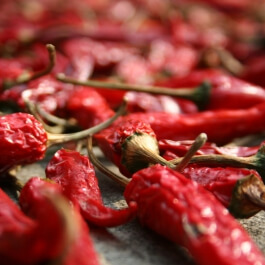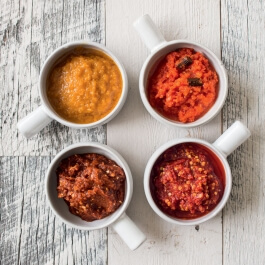Food
That Comes From Where? 13 Food Firsts You Won’t Believe
Slide Nr 1How sure are you that pizza originated in Italy? Or that sauerkraut is actually German? From spaghetti and meatballs to pizza, fortune cookies and French fries, we’ve dug up surprising details about the history of some of your favourite foods.
0/13
Food
That Comes From Where? 13 Food Firsts You Won’t Believe.
Slide Nr 2Pizza: Not As Italian As You Think – Pizza might be synonymous with Italian cuisine, but are its roots really Italian? According to popular belief, the first pizza was made in Naples for Queen Margherita of Savoy back in 1889, but recent studies cast doubt on this tale, with some historians suggesting that the progenitor of pizza was first made in ancient Greece almost 3,000 years ago. Apparently, the ancient Greeks had a flatbread called plakous, which was flavoured with toppings like cheese, herbs, onions and garlic, cut into slices served like modern pizza.
1/13
Food
That Comes From Where? 13 Food Firsts You Won’t Believe.
Slide Nr 3Fortune Cookies: Confucius Say “Not From China” – It’s no secret that a great number of Chinese restaurants in Western countries serve guests fortune cookies after their meal, a fact that has led many to believe that the crispy desserts are a Chinese invention. In reality, however, fortune cookies are not Chinese at all, but were popularised in America in the 20th century – likely based off of a type of cookie brought by Japanese immigrants to the country.
2/13
Food
That Comes From Where? 13 Food Firsts You Won’t Believe.
Slide Nr 4Churros: An Old-World Classic – Some might tell you that this delicious fried pastry originated in Mexico, but in fact churros were first brought to the New World from Portugal and Spain, where they are still enjoyed daily (often for breakfast, with a cup of hot cocoa for dunking). Going back even further, some say they were brought to Europe from China by the Portuguese, while others claim churros were invented by Spanish shepherds as a replacement for fresh bread, since churro dough was easier to make and fry over an open fire in the mountains.
3/13
Food
That Comes From Where? 13 Food Firsts You Won’t Believe.
Slide Nr 5Cheesecake: A Few Thousand Years Older Than New York – Cheesecakes are not only closely linked with a specific country, but a specific metropolis as well, since New York cheesecake is one of the most famous versions (some will claim the one of the most delicious, too). Cheesecake as a dish, however, is truly ancient. Historical sources have placed the famed dessert in ancient Greece as long ago as 776 BC, where it was served to the athletes of the first Olympics in history.
4/13
Food
That Comes From Where? 13 Food Firsts You Won’t Believe.
Slide Nr 6Croissants: About As French As Arnold Schwarzenegger – When you think of French breakfast, you usually think of café au lait and a yummy croissant, but next time you enjoy one of those delectable flaky pastries, thank the Austrians – not the French – as the pastry finds its origins in the Austrian Kipferl, a crescent-shaped bread roll. The idea of croissants as a French creation has to do with Austrian baker August Zang, who opened a bakery in Paris in the early 1800s. His Kipferl became immediately popular and acquired a new name: croissants.
5/13
Food
That Comes From Where? 13 Food Firsts You Won’t Believe.
Slide Nr 7Spaghetti and Meatballs: Don’t Order This In Italy – Though many might think of it as a traditional Italian dish, if you go to Italy and ask for spaghetti and meatballs, it’s very possible that they’ll look at you like you’re crazy. There, meatballs are served alone as an appetiser, and you’ll find very few restaurants mixing them into pasta – if you do, it’s usually to satisfy the palates of American tourists. Yep, you guessed it: This dish is an American invention, widely believed to have its roots in Italian immigrant communities in New York.
6/13
Food
That Comes From Where? 13 Food Firsts You Won’t Believe.
Slide Nr 8Sauerkraut: Imported By Genghis Khan? – Sauerkraut (meaning “sour cabbage” in German) may be considered a traditional German dish, but in reality it comes from China – its provenance is often attributed to labourers constructing the Great Wall of China. The original Chinese sauerkraut is made from shredded cabbage fermented in rice wine, while in Germany it is dry cured by sprinkling salt on top. Various historical sources have suggested that sauerkraut was brought to Europe by Genghis Khan nearly a thousand years after the Chinese invented it. [Photo: erik forsberg/Flickr]
7/13
Food
That Comes From Where? 13 Food Firsts You Won’t Believe.
Slide Nr 9Tikka Masala: A Hot Dish From A Cold Country – Despite being famous as an Indian dish, tikka masala might not be that Indian after all. Many Scots swear that the dish was invented in Glasgow in the ‘70s by the Bangladeshi owner of an Indian restaurant (purportedly after a patron complained that he wanted gravy on his chicken tikka). Tikka masala was declared a national dish of the United Kingdom in 2001, but the spicy delight continues to fuel a heated debate over who has the right to claim it: the place where it was invented, or the place whose food culture inspired it. [Photo: erik forsberg/Flickr]
8/13
Food
That Comes From Where? 13 Food Firsts You Won’t Believe.
Slide Nr 10German Chocolate Cake: Not A Teutonic Torte – German chocolate cake is obviously from Germany, right? Wrong. This mouth-watering layered cake comes from the United States. Its origins go back to 1852, when an American baker named Samuel German developed a type of dark baking chocolate for the American Baker’s Chocolate Company, and the company named the chocolate after him. Later, in 1957, a recipe for German Chocolate Cake showed up in a Dallas newspaper, attributed to local homemaker Mrs. George Clay. The cake, which was named after the baking chocolate she used, quickly gained popularity across the States. [Photo: Kimberly Vardeman/Flickr]
9/13
Food
That Comes From Where? 13 Food Firsts You Won’t Believe.
Slide Nr 11French Fries: Just A Big Misunderstanding – What many consider to be the most famous French food worldwide might not be even French. According to certain accounts, the origins of so-called French fries date back to 17th-century Belgium, where poor villagers living in the Meuse Valley would fry the fish they caught in the river. However, in winter when the river froze, instead of fish they would fry small potatoes. The naming confusion is said to have occurred when WWI American soldiers tried these fried potatoes in the French-speaking Wallonia region of Belgium. Hearing the local language, they assumed they were in France. Thus, French fries.
10/13
Food
That Comes From Where? 13 Food Firsts You Won’t Believe.
Slide Nr 12Ketchup: A Multicultural Condiment – More than 95% of American kitchens contain a bottle of ketchup, but the famous sauce didn’t originate in the US, at least not in its earliest form. On his blog The Language of Food, Stanford University professor Dan Jurafsky records in detail the condiment’s long journey from Southeast Asia to China, then to Europe, and from there the United States. Even the name “ketchup” comes from the Hokkien Chinese kê-tsiap, a sauce derived from fermented fish. Early 18th-century British versions of ketchup would have been dark, runny sauces, often made from a base of mushrooms. Only in the 19th century was it first made from tomatoes – reportedly in the US, where it grew to become a classic.
11/13
Food
That Comes From Where? 13 Food Firsts You Won’t Believe.
Slide Nr 13Baklava: The Debate Ends – Both Greece and Turkey have been known to debate over baklava, both claiming the beloved dessert as part of their national cuisines. However, baklava is neither Greek nor Turkish, but instead of Assyrian origin. Historical accounts show that, as early as the 8th century BC, Assyrians would bake thin layers of dough with nuts, pour honey over it, and consume the delicious dessert – centuries before the Ottomans or Greeks could claim it as their own.
12/13
Food
That Comes From Where? 13 Food Firsts You Won’t Believe.
Slide Nr 14Apple Pie: Not Really “American As Apple Pie” – Despite the popular saying that “[insert object or concept] is American as apple pie”, apple pie actually isn’t. Pies as such can be traced back to ancient Egypt, Greece and Rome, where they were usually stuffed with meat and seafood. Sweet pies appear many centuries later, with the first apple pie being mentioned in 1589 by British poet Robert Greene, who in his work Menaphon mentions, “Thy breath is like the steeme of apple pies.”
13/13















Sorry, the comment form is closed at this time.